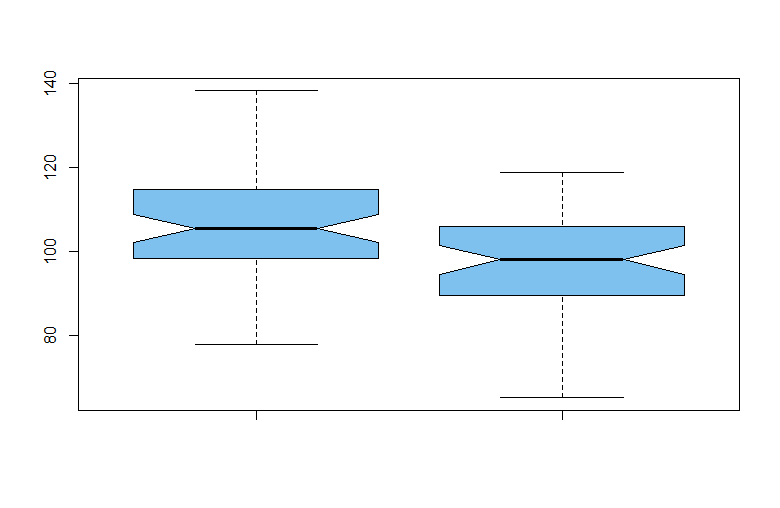Let's look at one variable at a time. As I understand it you have $n_1 =60$ observations from Population 1 which is distributed $\mathsf{Norm}(\mu_1, \sigma_1)$ and
$n_2 =60$ observations from Population 2 which is distributed $\mathsf{Norm}(\mu_2, \sigma_2).$
You want to test $H_0: \mu_1 = \mu_2$ against $H_a: \mu_1 \ne \mu_2.$
You could use a 2-sample t test. Unless you have prior experience with
such data indicating that $\sigma_1 = \sigma_2,$ it is considered good
practice to use the Welch (separate-variances) t test, which does not
require $\sigma_1 = \sigma_2.$
Specifically, suppose you have the following data:
sort(x1); summary(x1); sd(x1)
[1] 78.0 78.5 80.1 80.9 87.2 88.8 89.0 90.1 90.7 92.6 92.9 93.7 94.5 97.3 98.3
[16] 98.3 98.6 100.5 100.9 101.1 101.8 101.9 103.2 103.4 104.0 104.1 104.6 104.9 105.1 105.4
[31] 105.8 107.2 107.6 108.1 108.1 108.2 108.7 109.6 109.6 112.0 112.2 112.7 114.0 114.1 114.7
[46] 114.8 116.6 117.0 118.0 118.4 118.6 119.2 123.1 124.1 124.7 125.5 127.4 127.7 136.4 138.2
Min. 1st Qu. Median Mean 3rd Qu. Max.
78.0 98.3 105.6 106.2 114.7 138.2
[1] 13.55809
.
sort(x2); summary(x2); sd(x2)
[1] 65.3 70.1 76.1 76.8 80.9 81.3 82.4 82.5 84.9 85.0 85.6 86.6 87.7 88.6 89.4
[16] 89.7 90.3 91.9 92.2 92.5 93.0 93.0 93.5 94.0 94.4 96.1 96.4 96.9 97.3 97.6
[31] 98.5 98.9 99.7 99.9 100.2 101.3 101.5 101.7 103.3 103.4 103.5 103.6 104.5 104.7 106.0
[46] 106.2 107.2 107.7 109.2 109.3 110.5 110.7 110.9 111.1 111.3 113.8 114.9 115.2 118.1 118.9
Min. 1st Qu. Median Mean 3rd Qu. Max.
65.30 89.62 98.05 97.30 106.05 118.90
[1] 11.89914
boxplot(x1, x2, notch=T, col="skyblue2", pch=19)
There are no outliers in either sample and samples seem roughly symmetrical.
The notches in the sides of the boxplots are approximate nonparametric
confidence intervals, here indicating that the population medians differ.

The Welch 2-sample t test shows a significant difference. [A pooled t test would have had df = 118; because of a slight difference in sample standard deviations, the Welch test has only about df = 116.]
t.test(x1, x2)
Welch Two Sample t-test
data: x1 and x2
t = 3.8288, df = 116.05, p-value = 0.0002092
alternative hypothesis: true difference in means is not equal to 0
95 percent confidence interval:
4.304113 13.529220
sample estimates:
mean of x mean of y
106.2117 97.2950
Now for your specific concerns:
(1) For sample sizes of 60, you should not worry about a slight departure from
normality. If you feel nonnormality may be a problem you can look at all 120
'residuals' in this model together in one normality test. (The residuals
are $X_{1i} - \bar X_1, X_{2i} - \bar X_2.$ for $i=1, 2, \dots, 60.)$
(2) Any difference in variances is taken care of by doing the Welch 2-sample t test.
(3) The nonparametric two-sample Wilcoxon (signed-rank) test could be used if you really feel data are far from normality. This is a test to see if one population is shifted from the other. (Some authors frame this as testing for a difference
in medians, but a paper in this month's The American Statistician objects
to that interpretation and takes a broader view of the test: Dixon et al. (2018), Vol. 72, Nr. 3, "The Wilcoxon-Mann-Whitney procedure fails as a test of medians.") For my example, this test finds a significant difference between the two
populations, without assuming either population is normal.
wilcox.test(x1, x2)
Wilcoxon rank sum test with continuity correction
data: x1 and x2
W = 2465, p-value = 0.0004871
alternative hypothesis: true location shift is not equal to 0
(4) Addendum: A Comment and a linked Q&A mention permutation tests, so we include one possible permutation test. [For an elementary discussion of permutation tests, perhaps see Eudey et al. (2010), especially Sect. 3.]
Below is R code for
a permutation test using the pooled t statistic as 'metric'. If the two groups
are the same it should not matter if we randomly scramble the 120 observations
into two groups of 60. We recognize the pooled t statistic as a reasonable
way to measure the distance between two samples, but do not assume that statistic has Student's t distribution.
The code assumes data x1 and x2 are present, does the scrambling with the function sample(gp), and (conveniently, but somewhat inefficiently) uses t.test()$stat to get the t statistics of the permuted samples. The P-value 0.0003 indicates rejection
of the null hypothesis. (Results may vary slightly from one run to the next.)
all = c(x1, x2); gp = rep(1:2, each=60)
t.obs = t.test(all ~ gp, var.eq=T)$stat
t.prm = replicate( 10^5, t.test(all ~ sample(gp), var.eq=T)$stat )
mean(abs(t.prm) > abs(t.obs))
[1] 0.00026
The figure below shows a histogram of the simulated permutation distribution. [It happens
to match the density curve (black) of Student's t distribution with 118 degrees of freedom rather well, because data were simulated as normal with nearly equal SDs.] The
P-value is the proportion of permuted t statistics outside the vertical dotted lines.

Note: My data were generated in R as follows:
set.seed(818)
x1 = round(rnorm(60, 107, 15), 1); x2 = round(rnorm(60, 100, 14), 1)


